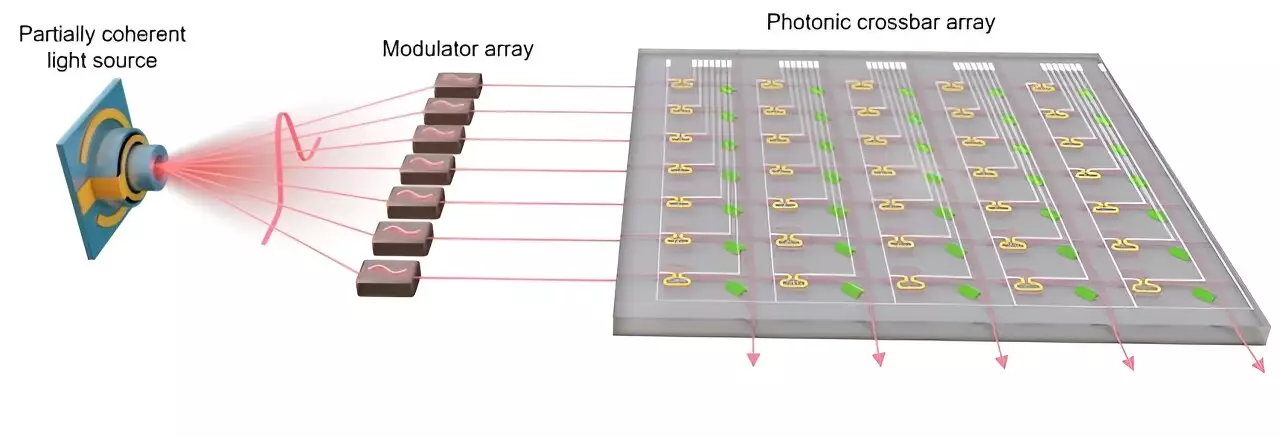In a groundbreaking study recently published in *Nature*, researchers from the University of Oxford, in collaboration with prominent institutions from Germany and Belgium, have unleashed a transformative concept in optical computing. The core of their discovery is simple yet profoundly impactful: lower-coherence light sources, often seen as inferior to their high-coherence counterparts, can significantly enhance certain optical applications. This revelation paves the way for rethinking traditional methodologies and technologies that have long depended on precision-engineered lasers. By exploiting the unique properties of partial coherence, researchers are on the brink of launching more efficient, cost-effective, and energy-saving light sources into the realm of artificial intelligence (AI) computation, fundamentally reshaping the landscape of photonic technologies.
Understanding Coherence: A Light-Based Conundrum
To grasp the implications of this research, one must first consider the concept of coherence in light. Coherence describes the consistency and correlation of waves in time and space, typically visualized in terms of color and wavelength. High-quality engineered light sources—such as lasers—exhibit extremely narrow wavelength ranges, appearing almost monochromatic and offering high levels of predictability. In contrast, low-coherence sources, akin to natural light from the sun or typical light bulbs, disperse across a wide array of wavelengths. Traditionally, the scientific consensus has held that the precision afforded by coherent light should yield superior performance in applications like optical communications, medical imaging, and other high-tech domains.
This research significantly challenges that conventional narrative and opens a dialogue about the potential advantages that less coherent, more inclusive light sources can offer. For instance, the study provides compelling evidence that in a photonic AI accelerator—a cutting-edge technology utilizing photons for rapid computations—the advantages of low-coherence sources far surpass their so-called superior counterparts.
Pushing the Limits of AI with Photonic Technologies
The research team, led by Dr. Bowei Dong, innovatively employed partially coherent light sourced from an erbium-doped fiber amplifier. By leveraging this unconventional approach, they were able to distribute light across multiple input channels for AI computation. The results were astonishing: the researchers achieved a scaling effect that could accelerate computations by N times, with N representing the number of input channels. This means that in a scenario with a hundred input channels, computations could potentially be a hundred times faster compared to traditional laser setups.
Such dramatic acceleration is not merely theoretical; it found application in diagnosing Parkinson’s disease through gait analysis, reaching an impressive classification success rate of over 92%. This showcases not only the technical prowess of the new system but also reflects its potential real-world implications for healthcare and AI-driven diagnostics.
Environmental and Economic Impacts
Beyond technical advancements, this research holds the promise of broader implications in terms of environmental sustainability and economic feasibility. By favoring low-coherence light sources, which are generally cheaper and require less energy than lasers, the potential exists to radically lower operational costs while minimizing energy consumption. In an age where energy efficiency and cost-effectiveness are paramount, especially in tech-heavy industries, the shift toward utilizing ‘poorer’ light sources could herald a sustainable future for photonic technologies.
For instance, the concept of achieving speeds comparable to processing 100 billion operations per second, a feat previously reserved for high-spec coherent laser systems, raises the prospect of democratizing access to powerful AI computation and data processing capabilities. This could lead to a proliferation of advanced technologies in various sectors, maneuvering toward an era where limiting factors of high costs and extensive energy demands are significantly reduced.
Looking Forward: Expanding Horizons for Photonic Research
As researchers like Professor Harish Bhaskaran suggest, the implications of these findings stretch far beyond the boundaries of AI applications alone. The team aims to further explore whether the advantages of partially coherent light might extend into realms such as optical communications and interconnect technologies. The pursuit of optimizing light sources in these fields could lead to transformative innovations that shape the next generation of networking and communication systems.
This exciting leap into the unexplored territory of partial coherence is not just a testament to innovation but reflects the nature of scientific inquiry itself: challenging established norms to uncover hidden potentials. By embracing the unexpected benefits of less coherent light, researchers may very well be on their way to rewriting fundamental principles in the field of photonics, ensuring that the future is brighter, smarter, and far more interconnected than we can imagine.

